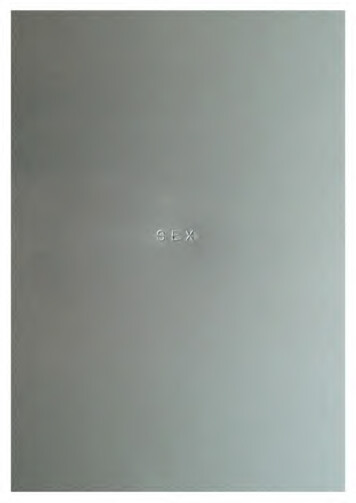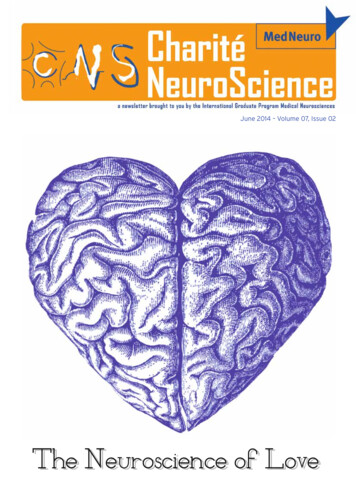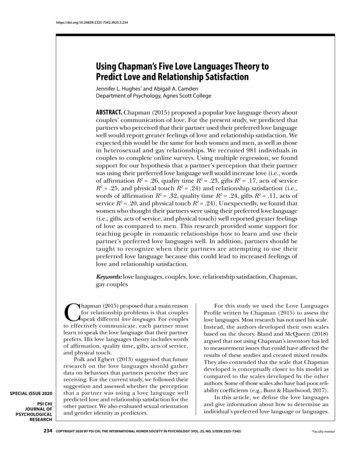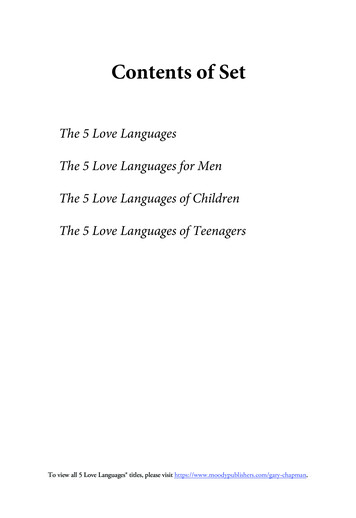
Transcription
Live to Work or Love to Work: Work Craving and WorkEngagementKamila Wojdylo1*, Nicola Baumann2*, Lis Fischbach2, Stefan Engeser21 Institute of Psychology, Polish Academy of Sciences, Warsaw, Poland, 2 Department of Psychology, University of Trier, Trier, GermanyAbstractObjective: According to the theory of work craving, a workaholic has a craving for self-worth compensatory incentives andan expectation of relief from negative affect experienced through neurotic perfectionism and an obsessive-compulsive styleof working. Research has shown that workaholism and work engagement should be considered as two distinct work styleswith different health consequences. However, the mechanisms underlying the adoption of these work styles have beenneglected. The present study proposes that work craving and work engagement are differentially associated with selfregulatory competencies and health. In particular, we expected that the working styles mediate the relationships betweenemotional self-regulation and health. Methods: In the cross-sectional study, 469 teachers from German schools completedonline administered questionnaires. By means of structural equation modeling, we tested two indirect paths: a) from selfrelaxation deficits via work craving to poor health and b) from self-motivation competencies via work engagement to goodhealth.Results: As expected, we found evidence that a) the negative relationship of self-relaxation deficits on health was partiallymediated by work craving and b) the positive relationship of self-motivation competencies on health was partially mediatedby work engagement.Conclusions: The present study emphasizes the importance of self-regulation competencies for healthy or unhealthy workstyles. Whereas work craving was associated with a low ability to down-regulate negative emotions and poor health, workengagement was associated with a high ability to up-regulate positive emotions and good health.Citation: Wojdylo K, Baumann N, Fischbach L, Engeser S (2014) Live to Work or Love to Work: Work Craving and Work Engagement. PLoS ONE 9(10): e106379.doi:10.1371/journal.pone.0106379Editor: Kenji Hashimoto, Chiba University Center for Forensic Mental Health, JapanReceived December 21, 2013; Accepted August 6, 2014; Published October 8, 2014Copyright: ß 2014 Wojdylo et al. This is an open-access article distributed under the terms of the Creative Commons Attribution License, which permitsunrestricted use, distribution, and reproduction in any medium, provided the original author and source are credited.Funding: This project was supported by Polish National Science Centre Grant (DEC/2011/01/M/HS6/02567). The funders had no role in study design, datacollection and analysis, decision to publish, or preparation of the manuscript.Competing Interests: The authors have declared that no competing interests exist.* Email: kamila.wojdylo@psych.pan.pl (KW); nicola.baumann@uni-trier.de (NB)IntroductionWorkaholism versus Work EngagementWork engagement has been proven to be an empirically distinctconstruct from workaholism [5], [6]. Work engagement is definedas a positive, fullfilling, work-related state of mind characterized byvigor (energy, concentration, strain, persistence in the face ofinconviniencies), dedication (inspiration and challenge, full of workenthusiasm) and absorption (like an enduring flow-experience) [7].Although the concept of work engagement was clearly defined, theconcept of workaholism remained vague because of two reasons.First, work engagement is still considered by some scholars as apossible dimension of workaholism (e.g., [8]). Second, recentconceptualisations of workaholism propose obsessive inner drive asthe core characteristic of workaholism and neglect its addictivenature (e.g., [7]). To avoid the vagueness of the concept of‘‘workaholism’’, we explicitly differentiate between work engagement and work addiction. Thus, in the present study, we adoptedthe conceptualization of workaholism as work craving [9], [10].Wojdylo [9] proposed the theory of work addiction, which shecalled work craving. She argued that the core characteristics ofwork addiction are not fully explained by obsessive inner drive butconstitute other addictive mechanisms. In her view, a mainmechanism of work addiction is the compensatory function ofSome people (workaholics) have a strong craving for workbecause they only feel worthy when working hard and perfectlywell whereas others (work engagers) are working hard because theyenjoy work. Although some studies have shown negativerelationships between workaholism and health [1], [2] or positiverelationships between work engagement and health [3], [4], theself-regulatory mechanisms behind these two different work styleshave been neglected so far. This research aimed at extendingcurrent knowledge in at least three respects. First, our focus on theassociations between emotional self-regulation, work styles, andhealth outcomes enhances an understanding of the role of personalcharacteristics in the etiology of workaholism and its healthconsequences. Second, our examination of the mediation betweenself-regulatory competencies and health underlines the importanceof work styles as mechanisms for individual well-being. Finally, ourdistinction between two work styles (i.e., work craving vs. workengagement) provides a differentiated picture of the relationshipsbetween work styles and health.PLOS ONE www.plosone.org1October 2014 Volume 9 Issue 10 e106379
Work Craving and Work Engagementbetween failure-related state orientation and psychosomatic symptoms, depression, low self-esteem, and self-consciousness [27], [30],[31] as well as workaholism [32].Decision-related action orientation (AOD) is the ability to upregulate positive affect, to overcome feelings of listlessness, and tofoster confidence and enthusiasm despite the presence ofchallenging demands and difficulties (high self-motivation). Thus,it is a decisive precondition for an efficient translation of intentionsinto action. In contrast, decision-related state orientation (the lowend of the AOD scale) denotes a low ability to self-generatepositive affect (low self-motivation) and it characterized byhesitation. Studies have linked decision-related state orientationto reduced well-being [27], a low ability to behave according toone’s preferences [33], procrastination [34] and workaholism [32].Hence, we hypothesize that self-relaxation and self- motivationcompetencies are negatively associated with work craving (H2a)and positively with work engagement (H2b). Furthermore, wehypothesize that self-relaxation and self-motivation competenciesare positively related with health indices (H3). Finally, we considerwork styles as mediators between self-regulation competencies andhealth. Despite the correlational nature of many of the reviewedfindings, self-regulation competencies are better conceived of asantecedents rather than consequences of work styles and healthbecause failure- and decision-related action orientation arepersonality dispositions that develop during early childhood andare rather stable over time [25], [26]. In addition, longitudinalfindings indicate that work styles precede rather than follow fromhealth states [14]. We hypothesize that the relationship betweenself-relaxation and self-motivation competencies and good healthis partially mediated by work engagement (H4a), and that therelationship between self-relaxation deficits and self-motivationdeficits and poor health is partially mediated by work craving(H4b).emotions, which explains the inner obsessive drive of workaholicsin fulfilling unrealistic standards of perfectionism. Thus, in contrastto previous theories of workaholism (e.g. [11], [7], [8]), theconceptualization of work craving constitutes a synthesis ofobsessive-compulsive and addictive elements. Specifically, inaddition to the compulsive/behavioral component, work cravingtheory includes two hedonic/affective components (anticipation ofself-worth compensation and anticipation of reduction of negativeaffect or withdrawal symptoms resulting from working), and alearning component (neurotic perfectionism) [9], [10]. Thus, workcraving is defined as an emotional-motivational state oriented atcompensation of negative emotions through an obsessive-compulsive work style and a desire for unrealistic (neurotic) perfectionisticstandards.Studies have shown that work engagement and workaholismhave distinct regulatory mechanisms and outcomes. Workaholismand work engagement share the behavioral component (workingexcessively hard, high work involvement), but the emotional andmotivational aspects of these phenomena differ fundamentally.Whereas workaholics are motivated by an obsessive inner drivethey cannot resist, engaged employees are intrinsically motivated,have a sense of energetic and effective connection with their workactivities, and view themselves as able to deal well with thedemands of their jobs [12]. These findings imply that workaholismand work engagement are differently related with self-regulationcompetencies (i.e., self-relaxation and self-motivation). Accordingto work craving theory, the emotion-regulatory componentsinherent in work craving (i.e., anticipation of reduction of negativeemotions and desire for self-worth compensatory incentives) implythat work craving should derive from low rather than high selfregulatory competencies [10].As mentioned above, studies have also shown that workaholismand work engagement are related with distinct outcomes. Workengagement is related to desirable outcomes like job and lifesatisfaction, better job performance and negatively associated withill being [13], [14]). Workaholism, in contrast, is related tonegative outcomes like psychosomatic symptoms, mental andphysical health complaints [15], [2], [16], [14], [10], pooremotional well-being [17], increased work-family conflict [18],and low life satisfaction [19], [20]). In the present study, wetherefore expected work craving to be negatively associated withhealth (H1a) and work engagement to be positively associated withhealth (H1b).Work Craving, Work Engagement, and Working HoursAccording to the view of lay people, working a lot can beequated to workaholism. From our point of view, working hoursand workaholism have to be separated. Wojdylo et al. [10]empirically showed that work cravers and work engagers didindeed work an equal number of hours. Thus, differences betweenwork craving and work engagement cannot be attributed todifferent hours of working but, instead, to different work stylesalone. We aspired to replicate these findings, so we also exploredthe relationship between working hours and the two different workstyles of work craving and work engagement. We hypothesize thatthe relationship between work craving and number of workedhours is low (H5).Emotional Self-Regulation and Well-BeingThe ability to self-regulate one’s feelings and thoughts plays animportant role in personality functioning [21], [22] and can bedifferentiated into two major self-regulation competencies: selfrelaxation and self-motivation [23], [24], [25]. Individual differences in self-relaxation and self-motivation competencies can beassessed by the failure- and decision-related action control scales,respectively [26]. In these scales, high levels of self-regulationcompetencies are called action orientation whereas low levels arecalled state orientation and indicate a low action orientation.Failure-related action orientation (AOF) is the ability to reducethe negative affect during or after confrontation with failure orthreat (high self-relaxation) and to keep up or even enhance accessto the self (i.e., implicit representations of own wishes, goals, andpreferences). Thus, it promotes the formation of realistic and selfcongruent goals and, in turn, well-being especially underthreatening conditions (e.g., [27], [28], [29]). In contrast, failurerelated state orientation (the low end of the AOF scale) denotes alow ability to self-regulate negative affect (low self-relaxation) andis characterized by ruminative thoughts. Studies found relationshipsPLOS ONE www.plosone.orgMethodWe decided to conduct our study in a sample of German schoolteachers for two reasons. First, differences between state- andaction-oriented individuals are typically observed under demanding conditions. We expected the workplace of teachers to besufficiently demanding to necessitate the use of self-regulationcompetencies (because of high stress conditions and emotionaldemands) and, therefore, to observe a benefit of action orientation.Second, because of the high work-related stress, burnout rates, andmental health problems among teachers in Germany [35], we alsoexpected to find sufficient levels of health complaints andunhealthy work style. When testing at schools in Germany, weneeded to go through an ethical board of the respective federalstate coordinating assessments at schools (ADD: Aufsichts- undDienstleistungsdirektion). The ADD of the federal state of2October 2014 Volume 9 Issue 10 e106379
Work Craving and Work EngagementRheinland-Pfalz approved our study (ADD approval 51 111-31/129-12). In addition, the representative for data security approvedour study (see attachment: Approval 6.08.22.001:0363). Participants were given detailed information about their rights and gavetheir informed consent through participation in the study.Participants have provided their written informed consent toparticipate in this study. Only data from participants were usedwho fully completed the study and did not send an e-mail to thestudy coordinator to refrain from the study.assess the ability to down-regulate negative affect following afailure, thus self-relaxation. An example item for AOF is ‘‘I’veworked for weeks on one project and then everything goes completelywrong: (a) It takes me a long time to get over it, or (b) It bothers mefor a while, but then I don’t think about it anymore’’. The decisionrelated dimension of action orientation (AOD) was used to assessthe ability to up-regulate positive affect preceding an action, thusself-motivation. An example item for AOD is ‘‘When I am gettingready to tackle a difficult problem: (a) It feels like I am facing a bigmountain that I don’t think I can climb,or (b) I look for a way thatthe problem can be approached in a suitable manner.’’ In theexample items, options "a" reflect the state-oriented responsealternatives and options "b" the action-oriented response alternatives. Each dimension of the scale consists of 12 items. For eachdimension, the action-oriented response alternatives were summedso that each scale ranged from 0 to 12, with lower scores indicatinglower action orientation (i.e. state orientation) and higher scoresindicating higher action orientation. For the AOF dimension a .84 and for the AOD dimension a .87.General health. The General Health Questionnaire (GHQ28, [38]) was used to assess the mental health status. The GHQhas four subscales: Somatic symptoms (‘‘Have you recently felt thatyou are ill?’’), anxiety and insomnia (‘‘Have you recently lost muchsleep over worry?’’), social dysfunction (‘‘Have you recently beentaking longer over the things you do?’’), and severe depression(‘‘Have you recently felt that life is not worth living?’’) with 7-itemseach. All 28 items were rated on four-point scales from 1 to 4 withslightly different labels across items. Items’ polarity was reversed sothat higher GHQ values correspond to better general mentalhealth. In the following analyses, only a general score wasconsidered (a .94).Working hours. Spent working hours was assessed by oneitem. Participants were asked to estimate the average daily hoursthey spend working: ‘‘How many hours do you actually work on anaverage day?’’ParticipantsThe present study is a part of the Work Craving InternationalProject (WCIP), a large cohort research realized in Poland andGermany (‘‘Work craving – personality antecedents and regulatory mechanisms’’). The WCIP aims at examining the newconceptualization of workaholism as work craving and itspersonality mechanisms [10].Four hundred and sixty-nine teachers from the Federal StateRheinland-Pfalz of Germany participated in the present study (345women and 121 men, 3 participants gave no information ongender). Participants were recruited via e-mail to all schoolprincipals across Rheinland-Pfalz. The principles were asked todistribute the information among the staff. Participants completedthe questionnaire voluntarily online which took about 45 minutes.Participants’ average age was 45 years (SD 10.57), with a rangeof 21 to 64 years. 62.5 % were married, 20.5 % were living in arelationship, 14.9 % were living alone, and 1.9 % did not provideinformation about their marital status. 36.7 % were teaching inprimary schools, 14.7 % in secondary/graduate schools, 16.2 % inspecial schools, 15.6 % in vocational schools, and 16.8% in otherschool forms. 63.1 % were employed full-time, 17.3 % worked30 hours a week, 11.7 % were employed part-time, 6 % workedless than part-time, and 1.9 % did not give information regardingtheir employment.Measures and ProcedureResultsAll questionnaires were administered online in a Germanversion.Work engagement. The Utrecht Work Engagement Scale(UWES, [36]) was used. The UWES consists of 17 items and hasthree subscales: Vigor (‘‘At my work, I feel bursting with energy’’),dedication, (‘‘I find the work that I do full of meaning andpurpose’’), and absorption (‘‘When I am working, I forgeteverything else around me’’). Items were scored by means of a 7point frequency rating scale ranging from 0 (never) to 6 (each day).We considered higher general scores as an indicator of higherwork engagement. The internal consistency (Cronbach’s Alpha) ofthe UWES was a .90.Work craving. The German version of 28-item WorkCraving Scale (WCS, [10]) was used to assess workaholism. TheWCS has four subscales (7 items each): Obsessive-compulsivedesire for work (‘‘I have an urge to work more and more’’),anticipation of self-worth compensatory incentives from work(‘‘Overworking makes me feel important’’), anticipation of reductionof negative affect and withdrawal symptoms (‘‘Working now wouldbring me a relief’’), and neurotic perfectionism (‘‘Even though Iperform a task very carefully, I feel that it is done not correctlyenough’’). Items were scored by means of a 7-point agreementrating scale ranging from 1 (not at all) to 7 (completely). In ourstudy, higher general scores were taken to indicate higher workcraving (a .95).Emotional self-regulation. Self-regulation competencieswere assessed by the Action Control Scale (ACS, [37]). Thefailure-related dimension of action orientation (AOF) was used toPLOS ONE www.plosone.orgDescriptives and correlationsTable 1 presents an overview of the descriptive results andcorrelations for the study variables. As expected, work cravingcorrelated negatively (H1a) and work engagement positively withhealth (H1b). Second, self-regulatory competencies (AOF andAOD) correlated negatively with work craving (H2a) andpositively with work engagement (H2b). Third, self-relaxation(AOF) and self-motivation (AOD) showed significantly positivecorrelations with health (H3) and with each other. Contrary toprevious findings [10], there was a significant relationship betweenwork craving and working hours, but the relationship was veryweak (r .10) indicating that work craving cannot be inferredfrom working hours (H5). Finally, in compliance with previousfindings [10], the correlation between work engagement and workcraving was very small indicating that they are distinct work styles.Structural equation modelingTo further test our hypotheses regarding meditational effects(H4a and H4b), we used structural equation modeling (SEM). Wedesigned a path-model (Figure 1, Model A) allowing us to test thefour mediation assumptions at the same time: that work cravingmediates between self-relaxation deficits and poor health andbetween self-motivation deficits and poor health whereas workengagement mediates between self-relaxation competencies andgood health and between self-motivation competencies and goodhealth. The Model Fit was estimated by means of Mplus6 [39].3October 2014 Volume 9 Issue 10 e106379
Work Craving and Work ***.34***.22***.41***2.53***.24***PLOS ONE www.plosone.org1.0 – 1521 – 64The aim of the present paper was to understand more preciselythe differences between work craving and work engagement, theirregulatory mechanisms, and outcomes. Our study showed thatwork cravers have low abilities in self-relaxation as well as lowabilities in self-motivation, whereas work engagers have high selfregulatory abilities of both types. These findings are consistentwith and extent findings regarding motivational differencesbetween workaholics and engaged employees. Van Beek, Hu,Schaufeli, Taris, and Schreurs [42], for example, found thatworkaholic employees feel motivated by instrumental values andtend to introject goals whereas engaged employees work not justfor the instrumental value, but also value the work itself andintegrate goals into the self (see also: [43]). These motivationaldifferences can be explained by the presently observed differencesin self-regulation competencies between work cravers and workengagers. According to Kuhl [24], [25] self-regulation competencies form the basis for the creation of realistic, self-congruent goalsand self-determination [27], [28], [29]. Thus, motivationaldifferences between workaholics (motivated by introjected goals)and work engagers (motivated by integrated goals) can beexplained by self-regulatory deficits and self-regulatory competencies. This notion, of course, requires father exploration in the nextstudy.The present study supported our assumption that work cravingand work engagement are partial mediators between selfregulatory competencies and health symptoms. Interestingly,although both types of self-regulatory abilities were associatedwith more healthy and less unhealthy work styles, results indicateddistinct mediating roles of work engagement and work craving.(7) AgeNote. afemale 1; male 2. bN 436. cN 459.* p ,.05 ** p ,.01 *** p ,.001.doi:10.1371/journal.pone.0106379.t0010 – 242.3610.5744.947.68bc(6) Working Hours1.0 – 3.91–43.12(5) General Health (GHQ)0.451.0 – 6.41–72.78(4) Work Craving (WCS)1.092.2 – 7.01–75.64(3) Work Engagement (UWES)0.840 – 120 – 120 – 123.665.967.54(2) Action Orientation (AOD)3.460 – 12.52***Discussion(1) Action Orientation (AOF)(2)RangeScaleSDMTable 1. Descriptives and Bivariate Correlations (Pearson) Between Study Variables (N 469).(5)(6)(7)(4)(3)GenderaThe regression coefficients were adjoined to the hypotheticalModel A in Figure 1. For Model A, good fit indices were achieved(CFI .96; SRMR .04; x2(1) 17.997). The cut off ranges forthe absolute fit indices were achieved (cf. [40], [41]). Looking atthe path coefficients of Model A, work craving was associated withlower general health whereas AOD, AOF, and work engagementwere associated with higher general health. Most important forour theoretical expectations, only the paths from AOF to workcraving and from AOD to work engagement were significant,whereas the paths from AOF to work engagement and from AODto work craving were low and not significant.According to these results, we tested an alternative model(Figure 1, Model B) with only two indirect paths at the same time:that work craving mediates between self-relaxation deficits andpoor health whereas work engagement mediates between selfmotivation competencies and good health. Model B reached witha CFI .997, SRMR .019, and x2(2) 3.27 a generally goodfit. We found significant direct effects from AOF and AOD onhealth (bAOF .20, p ,.01; bAOD .11, p ,.01). Consistent withexpectations, we also found significant indirect effects from AOFthrough work craving on health (H4a: bAOF WCS -.19, p ,.05)and from AOD through work engagement on health (H4b:bAOD UWES 2.08, p ,.05).When comparing the model fit of the competing models A andB, Model B reached a better fit. According to the chi squaredifference test, the difference between the models was significant(Dx2(1) 14.72, p ,.001. The findings indicated that therelationship between self-relaxation deficits (but not by selfmotivation deficits) and poor health was partially mediated bywork craving whereas the relationship between self-motivationcompetencies (but not self-relaxation competencies) and goodhealth was partially mediated by work engagement.4October 2014 Volume 9 Issue 10 e106379
Work Craving and Work EngagementFigure 1. Regression coefficients of two path models tested through structural equation modeling. Indirect path coefficients are inparentheses. The residual variance components (error variances) indicate the amount of unexplained variance. For each observed variable, R2 (1 error variance). * p ,.05 *** p ,.001.doi:10.1371/journal.pone.0106379.g001Work engagement, on the other hand, was associated in ourstudy in particular with a high ability to self-regulate positiveemotions (high self-motivation). Work engagers’ high self-motivation competencies make it easier to bring up the positive affectneeded to translate an intention into action and contribute to anidentification with their goals [42]. They know how they canplease themselves and savor the immediate hedonic affect inherentin working. In an experience sampling study by Bledow, Schmitt,Frese, and Kühnel [46], work engagement was strongest amongemployees who had a negative onset and managed to shift to apositive mood throughout their working day. Consistent with ourfindings, these affective shifts were supported by personal resources(i.e., dispositional affectivity) related to high positive rather thanlow negative affect. Our findings extent the work by Bledow et al.[46] by showing that personal resources for work engagement arenot restricted to affect sensitivity (i.e., how easily one enters anemotional state) but also available at the level of affect regulation(i.e., how easily one leaves and actively changes an emotional stateonce it is aroused) [23]. This is informative because people’s affectsensitivity is more genetically predisposed and less malleablethrough training than their affect regulation competencies (cf.[25]).To summarize, the present results revealed that work cravingand work engagement have distinct self-regulatory underpinningsHigh work craving partially mediated the relationship betweenself-relaxation deficits (but not self-motivation deficits) and poorhealth whereas high work engagement partially mediated therelationship between self-motivation competencies (but not selfrelaxation competencies) and good health.Work craving, on the one hand, was fueled in our study inparticular by a low ability to self-regulate negative emotions (lowself-relaxation). This finding is consistent with Kuhl’s [25], [44]theorizing that overworking may be a coping strategy thatsuppresses negative feelings without truly self-regulating them.Work cravers’ self-relaxation deficits indicate reduced access to theself that might express itself in their tendency to set unrealisticallyhigh standards of achievement. Because workaholics do notcompletely lack self-motivation and/or use external sources ofmotivation (cf. [42]), they are able to become initiative and strivefor their overly high standards of excellence. Unreachablestandards keep them busy and distracted from negative feelings.However, distraction through overworking does not solve anyproblems or promote success because workaholics’ goals areunrealistically high [45] and introjected rather than integrated intothe self [42], [43]. Thus, work craving may instigate a vicious‘‘loss-of-autonomy’’ cycle [33] in which the self is suppressed,conflict accumulated, effortful control increased, and the self evenfurther suppressed.PLOS ONE www.plosone.org5October 2014 Volume 9 Issue 10 e106379
Work Craving and Work Engagementand opposing effects on health. Despite the high correlation, selfrelaxation and self-motivation competencies show functionaldissociations: whereas self-relaxation competencies obviate workcraving, self-motivation competencies abet work engagement.These specific effects on two distinct work styles are part of thereasons why self-relaxation and self-motivation contribute toemployees’ general health.Furthermore, in earlier research on workaholism, hard workerswho worked long hours while experiencing an inner drive werebranded workaholics. For a long time, workaholism was definedand measured as excessive working, that is, by quantity (e.g., [47]).Our results replicated the finding by Wojdylo et al. [10] that workcraving is only weakly correlated with and cannot be reduced tospending more time at work.suffering from alcoholism deny drinking. Thus, our presentfindings should be validated with more objective measures orwith additional ratings from family members regarding criteria forwork craving.Practical ImplicationsAs for the practical implications of the present study, it isinformative to see that not only current motivational states such ascontrolled/autonomous motivation [43] or introjected/identifiedmotivation (cf. [42]) but also individual differences in the ability toself-regulate emotions (i.e., action vs. state orientation) are stronglyassociated with workaholism and work engagement. The role ofself-regulation in the etiology of work craving/work engagementhas received less attention than would be warranted whenconsidering the strength of the relationships. Especially a lack ofself-relaxation was strongly associated with work craving, suggesting that the concepts of self-regulatory competencies may be agood starting point for interventions at the individual andorganizational level to prevent and
1Institute of Psychology, Polish Academy of Sciences, Warsaw, Poland, 2Department of Psychology, University of Trier, Trier, Germany . Kenji Hashimoto, Chiba University Center for Forensic Mental Health, Japan Received December 21, 2013; Accepted August 6, 2014; Published October 8, 2014 . state coordinating assessments at schools (ADD .











